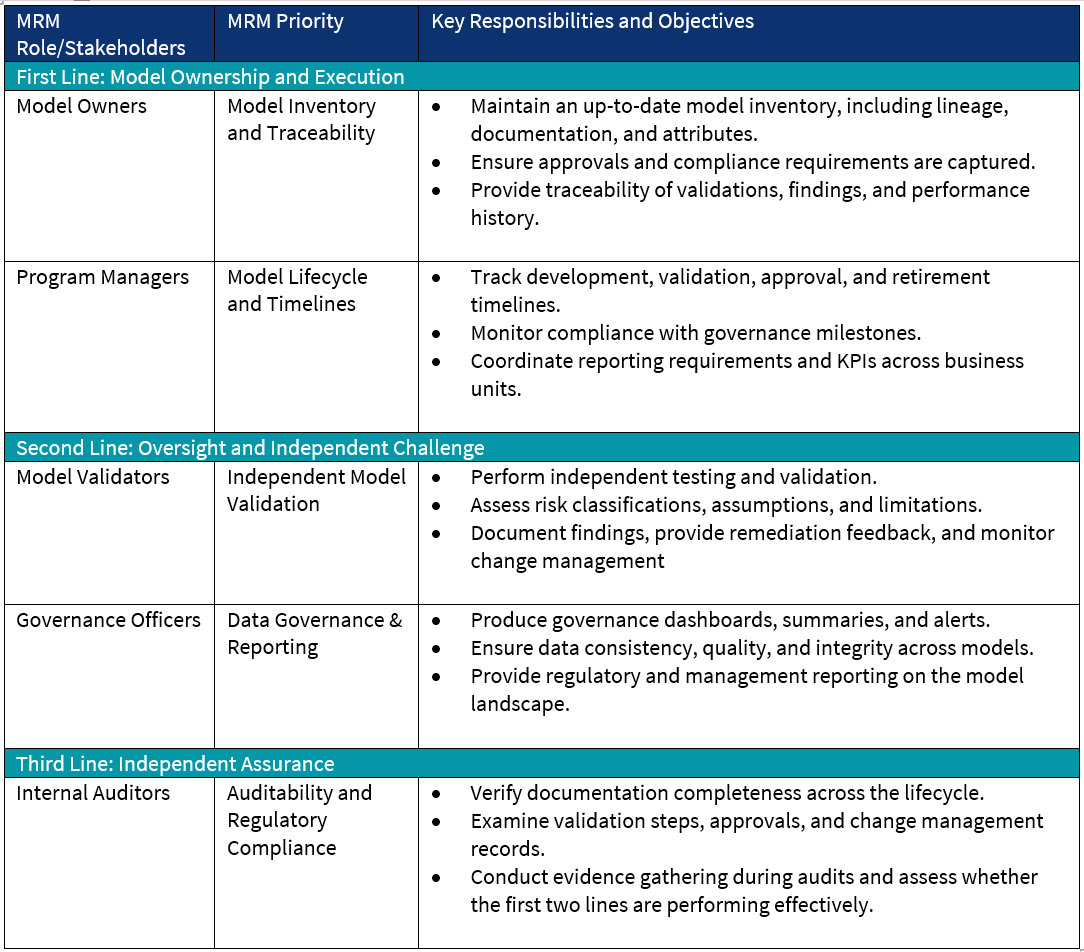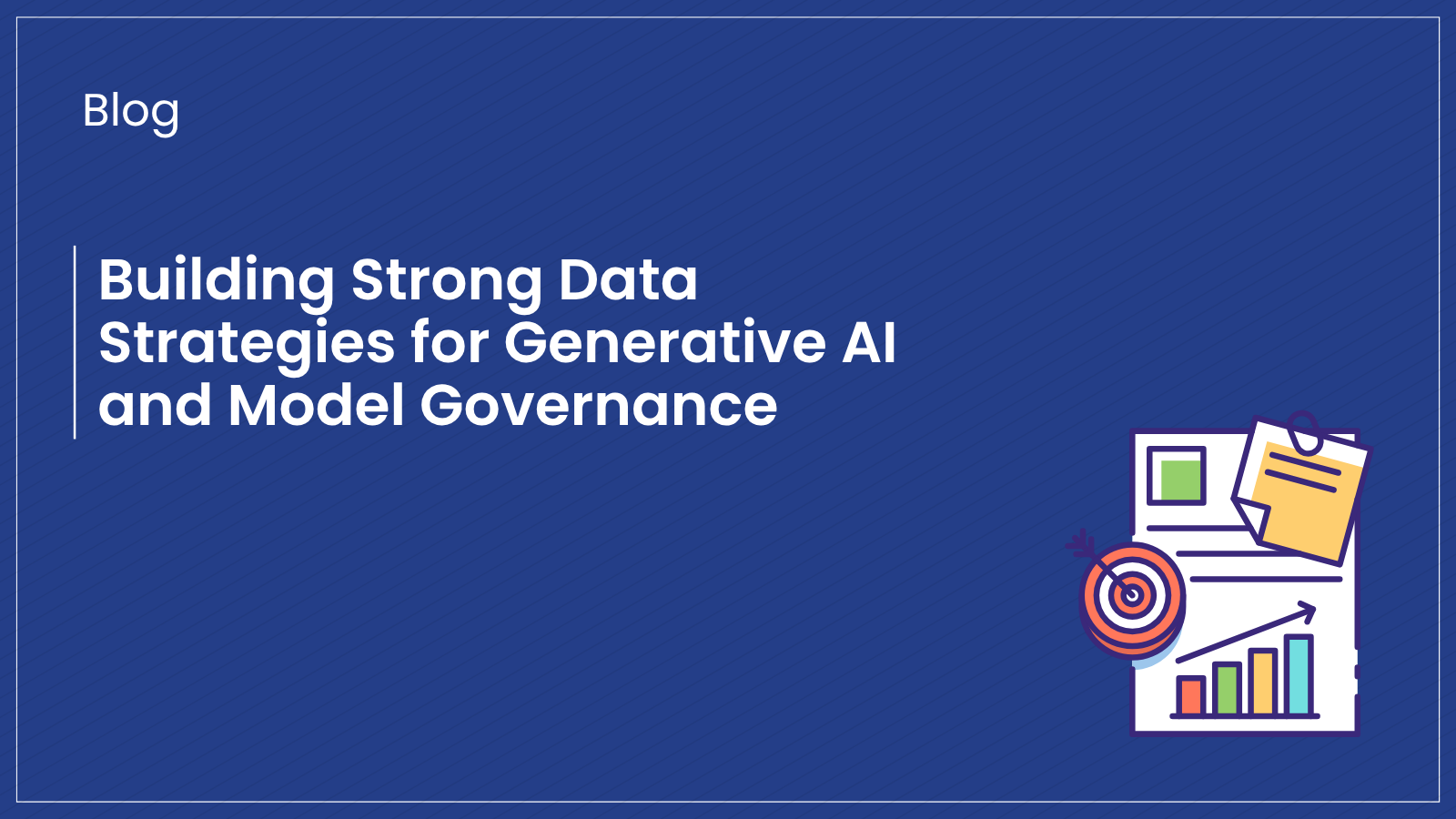Model Risk Management (MRM) governance is only as strong as the people, processes, and oversight structures that support it. The three lines of defense framework is a cornerstone of effective MRM, ensuring models are developed, validated, and audited with independence and accountability.
But in practice, institutions must go further than theory. Maintaining a robust model inventory, defining granular roles, and setting clear access privileges are essential so responsibilities cascade correctly through each stage of the model lifecycle. This clarity helps institutions meet regulatory expectations, strengthen collaboration, and protect against operational and reputational risk.
Why Clearly Articulated Roles and Responsibilities Matter?
Defining the roles and responsibilities of stakeholders in model inventory and governance is essential to:
- Establish Accountability: Clear role definitions prevent duplication or gaps across the model lifecycle.
- Ensure Transparency: Documented responsibilities give regulators and senior management confidence that governance is driven by people and processes, not just tools.
- Enable Regulatory Compliance: Supervisors expect institutions to demonstrate structured oversight aligned with frameworks such as SR 11-7 (U.S.), OCC guidance, and PRA SS1/23 (U.K.).
- Empower Resilience: Defined roles help onboard new staff, ensure business continuity, and strengthen audit readiness.
By clearly articulating what model owners, validators, auditors, program managers, and governance officers actually do, institutions can demonstrate prudent oversight, structured accountability, and proactive risk management.
What are the Three Lines of Defense in MRM?
The traditional three lines of defense framework aligns directly with MRM roles, priorities, and clearly defined objectives.

Case Study: How a Retail Bank Changed Its Model Risk Management Using the Three Lines of Defense
Scenario
A large retail bank faced gaps in its model governance framework: missing controls, fragmented approvals, and inconsistent documentation. Regulators had raised concerns, and leadership committed to strengthening MRM by applying the three lines of defense more rigorously.
What They Did
- First line (Model Owners & Developers): Partnered with the MRM team to build a centralized inventory system. Each model was assigned an owner, with full traceability of validation records and supporting documentation.
- Second line (Validation Team): Established as an independent risk function reporting to the Chief Risk Officer. Models were classified into high, medium, and low-risk tiers, with strict validation standards applied accordingly.
- Third line (Internal Audit): Designed a recurring review plan to assess whether ownership and validation controls were functioning as intended.
The bank also implemented an integrated MRM platform to automate inventory tracking, approvals, workflows, and reporting.
The Results
- Within 4 months, all models were consolidated into a single system, with risk ratings and clear ownership assigned.
- Escalation rules were introduced to flag risky models before deployment.
- The bank achieved a 70% productivity gain by centralizing workflows, approvals, and documentation.
- Most importantly, regulators reported increased confidence in the bank’s governance, and the institution passed a major review without significant findings.
Why It Mattered?
Beyond simple efficiency gains, the bank built stronger accountability across teams and established a governance structure capable of addressing new risks - particularly those arising from new-age ML/AI/GenAI models.
Creating a strong MRM governance setup for your organization
Effective model governance depends on clearly defined roles, responsibilities, and independence across the three lines of defense. Institutions that succeed will:
- Align accountability: Map ownership, validation, and audit roles explicitly to each line of defense.
- Automate oversight: Deploy platforms that centralize inventories, workflows, and approvals while enabling transparency.
- Invest in skills: Train and staff MRM teams with expertise in regulatory compliance, validation techniques, and emerging AI/ML risks.
- Earn regulatory trust: Demonstrate structured accountability through documentation, evidence, and ongoing monitoring.
As supervisory expectations expand, covering climate risk, AI governance, ESG integration, and other emerging factors and typologies - the three lines of defense remain a proven foundation for MRM. When executed with precision, this framework not only ensures compliance but also enhances resilience and trust in the institution’s ability to manage risk effectively.
How Solytics Can Help?
Strengthening Model Risk Management requires tools that can enable seamless collaboration across the three lines of defense. Solytics Partners’ MRMVault platform has been designed keeping in mind the unique needs and challenges of the various stakeholders.
For model owners in the first line of defense, MRM Vault simplifies the heavy lifting. Every model - whether AI/ML or vendor-supplied - can be logged, documented, and monitored in a single inventory, reducing the risk of shadow models and fragmented oversight.
The second line, responsible for risk and governance, benefits from automated validation workflows and risk-based categorization. Instead of relying on manual reviews, teams can ensure governance standards are applied consistently and evidence is captured in real time.
For the third line, audit and senior management gain visibility they rarely had before. With clear audit trails and customizable reports, regulators and boards can see not just policies on paper but governance in practice.
By combining technology with deep domain expertise, Solytics helps financial institutions cut compliance burdens, improve operational efficiency, and foster a culture where model governance is treated as a competitive advantage.
References
1. Comptroller’s Handbook - Model Risk Management
Link: Model Risk Management, Comptroller's Handbook
2. Board of Governors of the Federal Reserve System & Office of the Comptroller of the Currency
Link: SR 11-7 attachment: Supervisory Guidance on Model Risk Management
3. Prudential Regulation Authority - SS1/23 - Model Risk Management Principles for Banks
Link: SS1/23 – Model risk management principles for banks | Bank of England


.png)
_1.png)
_1.png)

.svg)


